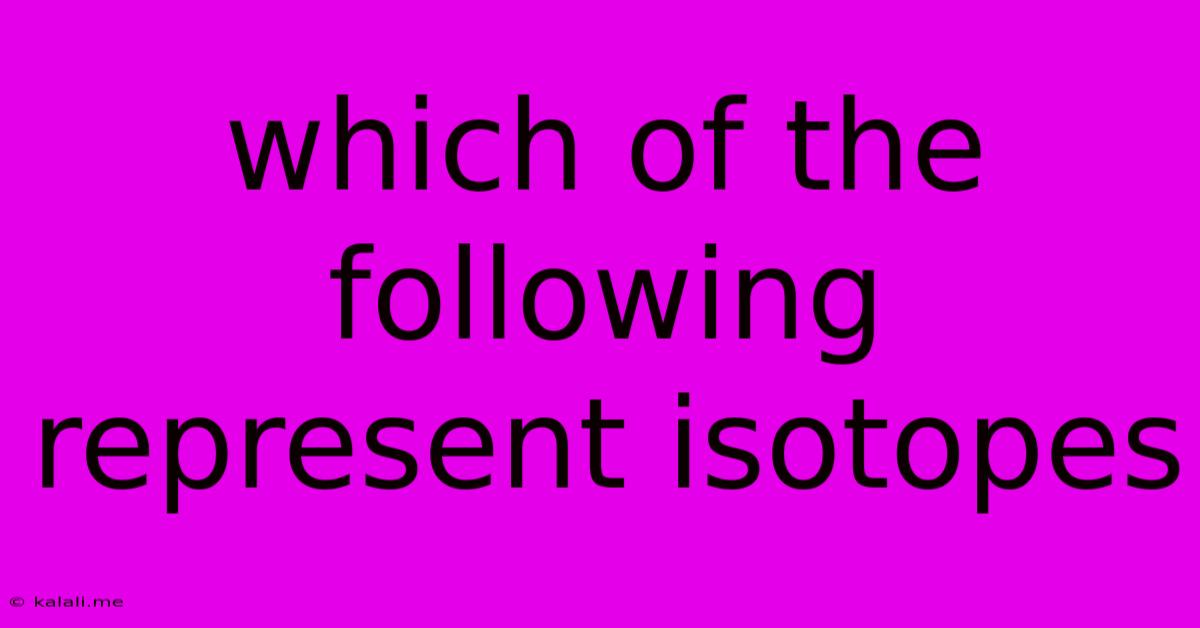Which Of The Following Represent Isotopes
Kalali
Jun 14, 2025 · 3 min read

Table of Contents
Which of the Following Represent Isotopes? Understanding Isotopes and Their Properties
This article will delve into the concept of isotopes, explaining what they are and how to identify them. We'll clarify the key characteristics that distinguish isotopes from other types of atoms, providing you with the knowledge to confidently determine which atoms are isotopes of each other. Understanding isotopes is crucial in various fields, including chemistry, physics, and nuclear medicine.
Isotopes are atoms of the same element that have the same number of protons but a different number of neutrons. This means they have the same atomic number (number of protons) but a different mass number (total number of protons and neutrons). Let's break down why this definition is so important.
What Defines an Element?
An element is defined by the number of protons in its nucleus. This number, also known as the atomic number, is unique to each element. For example, all atoms with one proton are hydrogen, all atoms with six protons are carbon, and all atoms with 92 protons are uranium. The number of protons determines the element's chemical properties.
The Role of Neutrons
While the number of protons defines the element, the number of neutrons can vary. These variations are what create isotopes. Neutrons contribute to the atom's mass but don't affect its chemical behavior significantly. This means that isotopes of the same element will generally react chemically in the same way.
Identifying Isotopes: A Step-by-Step Approach
To determine if a set of atoms represents isotopes, follow these steps:
- Identify the atomic number: Determine the number of protons for each atom.
- Compare atomic numbers: If the atomic numbers are different, the atoms are not isotopes. They represent different elements.
- Compare mass numbers: If the atomic numbers are the same (same element), compare the mass numbers (protons + neutrons). If the mass numbers are different, the atoms are isotopes of the same element.
Examples of Isotopes
Let's illustrate with some examples:
-
Carbon-12 (¹²C) and Carbon-14 (¹⁴C): Both have 6 protons (atomic number 6), but ¹²C has 6 neutrons and ¹⁴C has 8 neutrons. These are isotopes of carbon. Carbon-14 is a radioactive isotope used in carbon dating.
-
Hydrogen-1 (¹H, protium), Hydrogen-2 (²H, deuterium), and Hydrogen-3 (³H, tritium): All have 1 proton, but different numbers of neutrons (0, 1, and 2, respectively). These are all isotopes of hydrogen.
-
Oxygen-16 (¹⁶O) and Oxygen-18 (¹⁸O): These are both isotopes of oxygen, both possessing 8 protons, but differing in neutron count (8 and 10, respectively).
Non-Examples: When Atoms Are Not Isotopes
If the atomic numbers differ, the atoms are not isotopes. They are different elements altogether. For example, carbon (atomic number 6) and nitrogen (atomic number 7) are not isotopes, regardless of their mass numbers.
Conclusion
Understanding the difference between isotopes and other atoms is fundamental to grasping many scientific concepts. By focusing on the number of protons and neutrons, you can accurately identify whether a group of atoms represents isotopes of the same element or different elements entirely. Remember, the key is the same atomic number, but different mass numbers. This simple yet powerful distinction unlocks a deeper understanding of atomic structure and its implications.
Latest Posts
Latest Posts
-
Choose The Statement That Is True
Jun 15, 2025
-
Which Of The Following Is Similar Between Rna And Dna
Jun 15, 2025
-
What Act Score Do You Need To Get Into Lsu
Jun 15, 2025
-
Washington University In St Louis Gpa Requirements
Jun 15, 2025
-
Electron Volt Is The Unit Of
Jun 15, 2025
Related Post
Thank you for visiting our website which covers about Which Of The Following Represent Isotopes . We hope the information provided has been useful to you. Feel free to contact us if you have any questions or need further assistance. See you next time and don't miss to bookmark.